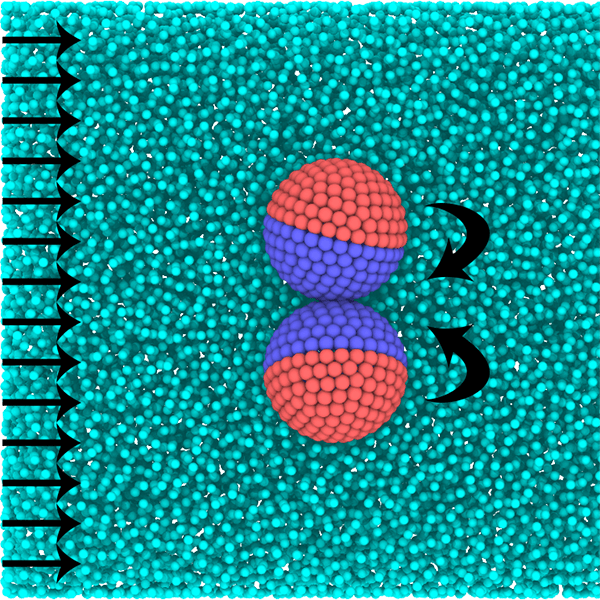Janus Particles & Soft Matter

CURRENT PROJECTS
Individual particles with interesting properties can assemble to make new types of soft matter.
Slippery Particles
When liquid flows over a surface, the liquid layer next to the surface is usually considered stationary. In recent times, very small violations of this “no-slip boundary condition” have been measured for water on hydrophobic surfaces. The motion of a particle on flow should be affected if it has a slippery surface [1]. We are carrying out experiments to test this theory, and using molecular dynamics simulations to understand the implications for asymmetric Janus particles in flows [2] and in dimers [3].
Collective Dynamics
We can also study the dynamics of two or more interacting Janus spheres. We are especially interested in how these particles come together to form interesting out-of-equilibrium phases [4]. In experimental work, we are trying to observe Janus colloids as they are brought together in a microfluidic system. Using molecular dynamics simulations, we can study these interactions and how they lead to clustering and dispersion under different conditions [5]. In theoretical work, we hope to model the phases and patterns which emerge in many-particle systems.
References
[1] Willmott, G. R. Slip-Induced Dynamics of Patterned and Janus-like Spheres in Laminar Flows. Phys. Rev. E 79, 066309 (2009).
[2] Safaei, S., Archereau, A. Y. M., Hendy, S. C. & Willmott, G. R. Molecular dynamics simulations of Janus nanoparticles in a fluid flow. Soft Matter 15, 6742-6752 (2019).
[3] Safaei, S., Hendy, S. C. & Willmott, G. R. Stability of amphiphilic Janus dimers in shear flow: a molecular dynamics study. Soft Matter 16, 7116 (2020).
[4] Chung, S., Safaei, S. & Willmott, G. R. 3D assembly of Janus spheres: potentials, dynamics, and experiments. Advances in Physics X 9, 2341759 (2024).
[5] Safaei, S., Todd, C., Yarndley, J., Hendy, S. C. & Willmott, G. R. Asymmetric assembly of Lennard-Jones Janus dimers. Phys. Rev. E 104, 024602 (2021).
Contact
Location: Building 303, 38 Princes Street, Auckland, New Zealand
Phone: +64 9 373 7599 ext 89998
Email: g.willmott[at]auckland.ac.nz

